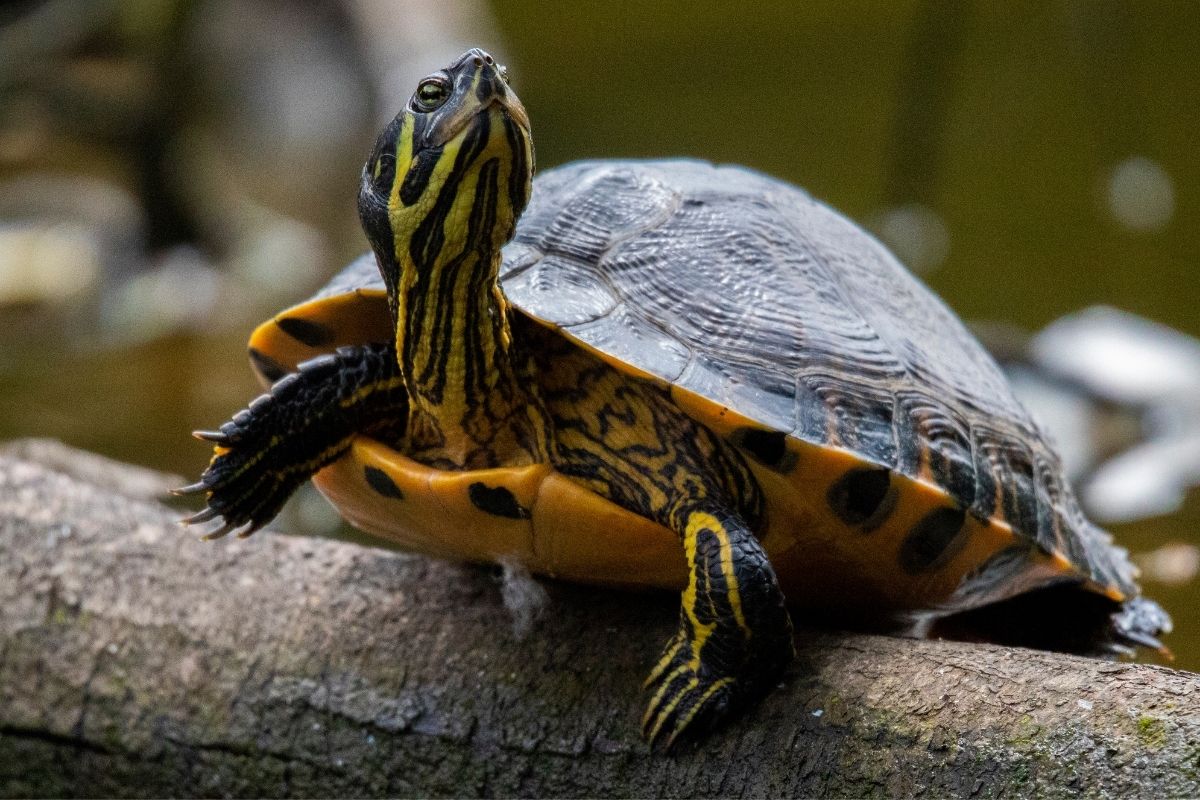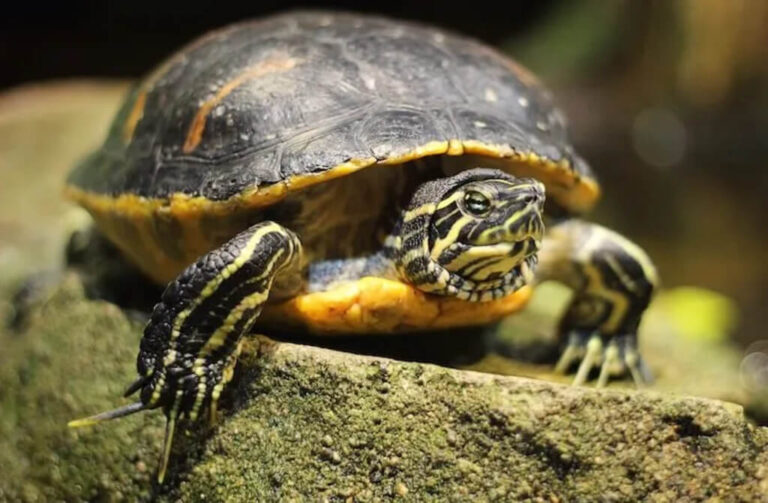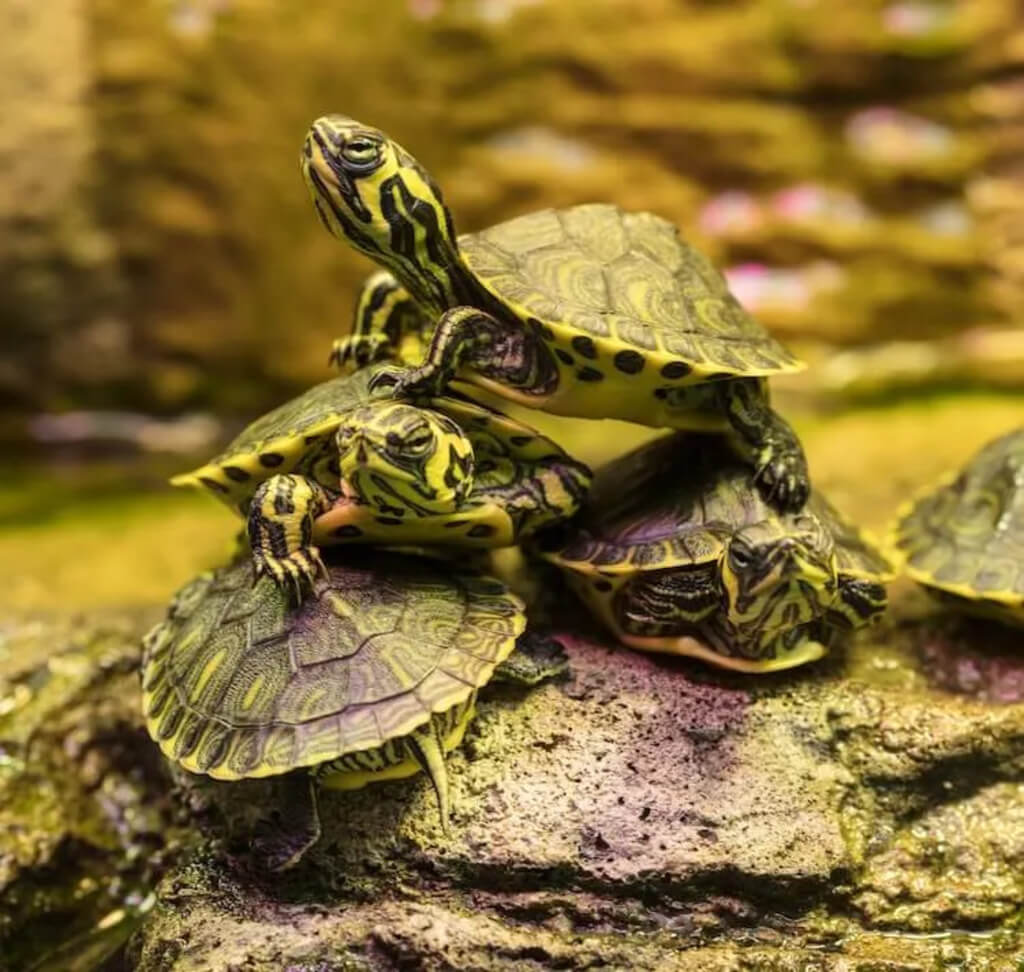If you are thinking about bringing a shelled companion into your home, the yellow belly turtle, sometimes called the yellow bellied turtle, or even the yellow belly terrapin, could be just what you are looking for. This type of turtle, you see, is often considered a wonderful choice for folks who are just starting out with keeping these fascinating creatures as pets. It has, in some respects, a rather agreeable disposition for a first-time owner, making the process of getting to know your new friend a little less complicated.
You might be surprised to hear just how widely cherished this particular kind of turtle is among people who keep pets. It's, well, truly one of the most frequently chosen aquatic companions out there, often appearing in many home setups. This popularity, actually, speaks volumes about how well they adapt to living alongside humans, provided their needs are met, of course.
Their widespread appeal is, in fact, quite remarkable, making them a common sight in the places where they naturally live, and very much a favorite for those who enjoy having a small, lively ecosystem in their own space. They are, basically, everywhere in their native waters and a true hit in the world of home aquariums, too.
Table of Contents
- What Makes a Yellow Belly Turtle a Good Pet?
- How Big Can a Yellow Belly Turtle Get?
- Understanding Yellow Belly Turtle Behaviors
- Why Do Yellow Belly Turtles Bask?
- What Does an Active Yellow Belly Turtle Do?
- The Yellow Belly Turtle in its Natural Home
- Yellow Belly Turtle Popularity
- Starting with a Yellow Belly Turtle
What Makes a Yellow Belly Turtle a Good Pet?
For someone just starting their adventure with a shelled creature, the yellow belly turtle, or yellow bellied terrapin as some call it, presents a rather inviting option. They are, in a way, quite forgiving, which is a wonderful trait for someone learning the ropes of caring for a water-dwelling reptile. This means they tend to be a little more resilient to the small mistakes new pet owners sometimes make.
Their general disposition, too, seems to be a good match for home environments. They are not, for example, overly shy or prone to extreme stress when kept by people. This makes the overall experience of having a yellow belly turtle a bit more pleasant and less of a constant worry for their human companions.
Compared to some other kinds of water turtles, like the map turtle, the yellow belly turtle often comes across as a less demanding creature. This isn't to say they don't need proper care, but rather that their basic requirements are, perhaps, a little simpler to provide for a beginner. You know, they are just a little more straightforward in their needs.
Their ability to adjust to different living situations also makes them a strong contender for a first pet. They are, actually, quite adaptable, which helps them settle into a new home with less fuss. This flexibility is a big plus for anyone who might feel a little unsure about keeping a turtle for the very first time.
So, if you are considering bringing a turtle into your life, the yellow belly turtle really does stand out as a sensible starting point. They offer, pretty much, a gentler introduction to the fascinating pastime of keeping these ancient creatures. It's, basically, a good way to begin your journey into turtle care.
How Big Can a Yellow Belly Turtle Get?
One common question people often have about the yellow belly turtle concerns their eventual size. It's, well, a good thing to think about before you bring one home, as their living space will need to match their adult dimensions. For the male yellow belly turtle, they can grow to be about nine inches long, which is a fair size for a turtle.
This measurement, you know, refers to the length of their top shell, or carapace. It gives you a good idea of the physical presence they will have in an enclosure. A nine-inch turtle is, basically, not a tiny creature, and it will need enough room to move around comfortably and perform its natural activities.
Knowing this potential size helps you plan for the future. You might start with a smaller setup when your yellow belly turtle is just a hatchling, but you will, in fact, need to upgrade to a much larger home as they get bigger. This planning is, perhaps, one of the most important aspects of providing a good life for your shelled friend.
So, while they might seem small at first, remember that these male yellow belly turtles have the capacity to become quite substantial. This means their environment, like their water area and basking spot, needs to be scaled up as they mature. It's, really, all about giving them the space they need to thrive.
Understanding Yellow Belly Turtle Behaviors
When you have a yellow belly turtle, getting to know what they do naturally is quite helpful. These creatures have a few key behaviors that are part of their everyday life, and observing them can be very interesting. They are, you know, quite active animals, and their movements tell you a lot about their well-being and instincts.
One of the things they are known to do is to go underwater, a movement we call diving. This action is, basically, part of their way of exploring their watery surroundings or perhaps looking for something to eat. It shows, in a way, their comfort with being fully submerged and their ability to move through different water depths.
They also spend a good amount of time swimming. A yellow belly turtle will, pretty much, glide through the water, using their limbs to propel themselves. This constant movement is a sign of their general health and their need for a watery area that allows for plenty of exercise. It's, actually, quite graceful to watch them move through their watery home.
Another very common behavior you will notice with a yellow belly turtle is basking. This involves them climbing out of the water onto a dry spot, often under a warm light. They will, in fact, sit there for periods of time, soaking up the warmth. This is a crucial part of their daily routine, and it serves several important purposes for their health.
Lastly, they are known for digging. A yellow belly turtle might, for example, try to burrow into the substrate at the bottom of their tank or in a soft area on land. This behavior is quite natural for them, mimicking what they would do in their wild homes, perhaps to find shelter or to lay eggs if they are female. It's, really, a deeply ingrained part of their instincts.
Why Do Yellow Belly Turtles Bask?
The act of basking, where a yellow belly turtle rests out of the water, is far more than just a leisurely sunbath. It is, in fact, a really important part of their daily life and health. This behavior is, basically, how they regulate their body temperature, since they are cold-blooded creatures and cannot produce their own heat.
When a yellow belly turtle climbs onto a dry spot, often under a heat lamp or in natural sunlight, they are absorbing warmth. This warmth, you know, helps their internal systems work correctly. It aids in their digestion, allowing them to process the food they have eaten more effectively. Without proper heat, their digestive system can slow down quite a bit.
Beyond just warmth, basking also exposes the yellow belly turtle to ultraviolet (UV) light, specifically UVB rays. These rays are, actually, crucial for them to make vitamin D3 in their skin. Vitamin D3 is, in turn, essential for them to properly absorb calcium from their diet, which is vital for strong bones and a healthy shell. So, it's a bit of a chain reaction for their well-being.
A good basking area also helps keep their shell and skin dry for periods. This dryness, in some respects, helps prevent certain skin and shell problems that can arise from being constantly wet. It's, pretty much, like drying off after a swim to avoid getting pruney or developing issues. So, it's not just about warmth, but also about keeping their outer layers in good shape.
So, when you see your yellow belly turtle perched on their basking spot, know that they are doing something truly vital for their well-being. Providing a proper basking setup with both heat and appropriate UV light is, therefore, a very important part of caring for your yellow belly turtle. It's, literally, a lifesaver for them.
What Does an Active Yellow Belly Turtle Do?
The yellow belly turtle is known for being quite active, which means they are often on the move and engaging with their surroundings. This characteristic activity level is, you know, a good indicator of their general health and contentment. An active yellow belly turtle is typically a happy and healthy one, basically.
Their activity includes a variety of movements within their watery home. They will, for instance, swim back and forth, exploring different areas of their tank. This constant motion is, in a way, their exercise, helping to keep their muscles strong and their bodies in good condition. It's like their daily workout, really.
Beyond just swimming, an active yellow belly turtle will also spend time exploring the bottom of their habitat. They might, for example, root around in the substrate, looking for bits of food or just satisfying their natural urge to investigate. This digging behavior is, actually, a common part of their active lifestyle.
They will also frequently move between the water and their basking area. This transition shows their responsiveness to their environment and their need to regulate their body temperature. An active yellow belly turtle will, pretty much, go back and forth as needed throughout the day, showing their engagement with their space.
So, when you observe your yellow belly turtle, look for these signs of movement and engagement. A yellow belly turtle that is often swimming, exploring, basking, and sometimes digging, is demonstrating its natural, lively spirit. It's, truly, a joy to watch them display these behaviors in their home.
The Yellow Belly Turtle in its Natural Home
The yellow belly turtle, sometimes called the yellow bellied terrapin, has a particular kind of natural living space. They are, you see, a subspecies of pond turtle, which gives us a good idea of the type of environment they prefer. This means their wild homes are typically bodies of fresh water that are not too deep, like ponds, slow-moving rivers, and marshes.
Being a pond subspecies means they are well-suited to living in areas where there is both water for swimming and land for basking. Their bodies are, in fact, designed for this kind of dual environment, allowing them to thrive both in and out of the water. It's, basically, what they are built for.
In their native areas, the yellow belly turtle is quite a common sight. It is, pretty much, the most frequently encountered turtle species within its natural distribution range. This prevalence suggests that they are very successful at living and reproducing in these specific types of watery habitats. They are, you know, quite abundant where they belong.
Their ability to flourish in these watery settings, which often include plenty of vegetation and spots for sunning, contributes to their high numbers. They find, in some respects, everything they need to survive and grow in these pond-like settings. So, it's no wonder they are so widely found in their natural haunts.
Understanding their natural habitat helps us, in turn, provide a good home for them as pets. Knowing they are pond dwellers means we should aim to recreate a similar environment in their enclosure, complete with ample water and a suitable dry area. It's, really, all about mimicking their preferred way of life.
Yellow Belly Turtle Popularity
The yellow belly turtle holds a special place in the hearts of many people who enjoy keeping turtles as companions. This species is, you know, truly one of the most widely chosen pet turtles around, and its appeal seems to grow steadily. You see them quite often in home aquariums, showing just how much people like them.
Their popularity stems from a few different things. For one, their general temperament makes them a good fit for home life. They are, in a way, quite calm and adaptable, which helps them settle into new surroundings. This makes them a pleasant addition to many households, basically.
Also, their appearance is quite charming. The distinct yellow markings on their underside, which give them their name, are, in fact, rather attractive. People are often drawn to their bright coloration and the way it stands out. It's, pretty much, a very eye-catching feature.
Beyond their looks and demeanor, the fact that they are considered a good choice for beginners also adds to their widespread appeal. People who are new to turtle keeping often gravitate towards a species that is known to be a little more forgiving. This makes the yellow belly turtle a very sensible first choice for many, too.
So, it is not just by chance that the yellow belly turtle is so commonly seen in homes and is the most common turtle in its natural areas. Their combination of agreeable traits and relative ease of care has made them a firm favorite. They are, truly, a well-liked and widely kept aquatic companion.
Starting with a Yellow Belly Turtle
If you are thinking about welcoming a yellow belly turtle into your life, there are a few general things to keep in mind from the start. Since they are considered a good choice for people new to turtles, getting things right from the beginning will make the experience much smoother for both you and your new friend. It's, in a way, about setting them up for success.
Considering their size, especially for male yellow belly turtles who can grow to about nine inches, means planning for a suitably large habitat. A small tank might be fine for a tiny hatchling, but they will, eventually, need a much bigger space to swim, explore, and bask comfortably. This foresight is, pretty much, essential for their well-being.
Because they are a subspecies of pond turtle, their home needs to have both a good amount of water and a dry area where they can get completely out of the water. This dry spot, you know, is where they will perform their important basking behavior, which is vital for their health. So, providing both elements is a must.
Understanding their active nature is also key. The yellow belly turtle likes to dive, swim, bask, and dig, so their environment should allow for all these natural actions. This means, for example, having enough depth for swimming and diving, and perhaps some substrate for them to dig into. It's, really, about creating an engaging space for them.
Their popularity as an aquarium pet and their commonness in their native range speak to their general adaptability. However, this adaptability does not mean they don't need proper care and attention. They still need, basically, a consistent and suitable environment to thrive. So, while they are good for beginners, they still require commitment and thoughtful care.
When you bring a yellow belly turtle home, watching their behaviors like swimming, basking, and digging will tell you a lot about how they are doing. An active yellow belly turtle that uses all parts of its habitat is, generally, a happy one. So, observing them regularly is a good way to stay connected with your new companion, too.
This species, known for being a wonderful beginner's pet, truly brings a lot of life to a home. By understanding their basic needs and natural tendencies, you can provide a fulfilling life for your yellow belly turtle. It's, honestly, a rewarding experience to care for these fascinating creatures.
The article has covered the yellow belly turtle, also known as the yellow bellied turtle or yellow belly terrapin, as a good beginner's pet, its popularity, the size males can reach, its classification as a pond subspecies, its commonness in its natural habitat and as an aquarium pet, and its active behaviors including diving, swimming, basking, and digging.
Related Resources:



Detail Author:
- Name : Dayton Weber IV
- Username : katherine.beatty
- Email : wintheiser.malcolm@gmail.com
- Birthdate : 1992-03-28
- Address : 96539 Alessandra Expressway New Tyshawnshire, NY 50908-6604
- Phone : 1-608-965-4945
- Company : Stokes-Cummerata
- Job : Captain
- Bio : Eligendi repellendus nesciunt excepturi reprehenderit eaque accusantium eveniet. Aperiam ab officia exercitationem necessitatibus sint et tenetur esse. Quam aut nam id voluptatem dolores qui.
Socials
instagram:
- url : https://instagram.com/muhammad_real
- username : muhammad_real
- bio : Aspernatur vel quas velit et et. Nisi maiores voluptas perspiciatis.
- followers : 213
- following : 270
tiktok:
- url : https://tiktok.com/@muhammad.schaefer
- username : muhammad.schaefer
- bio : Possimus eligendi architecto debitis voluptate saepe.
- followers : 604
- following : 2402